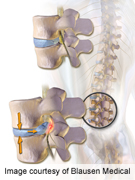
WEDNESDAY, March 13 (HealthDay News) — Even though expensive MRIs produce very detailed images for assessing back pain, they may not be very good at evaluating results after treatment, research suggests.
Many physicians order an MRI before and after treatment of patients with lumbar-disk herniation and persistent sciatica. But some experts say spine imaging is overused and not necessarily accurate in certain cases.
This new study used MRI scans from a study initially designed to compare surgery to conservative care for sciatica, which is pain or weakness that radiates from the back down the leg. The researchers compared a person’s first MRI to their follow-up MRI taken a year later. They couldn’t tell from the follow-up MRIs who had good results and who didn’t.
“The discriminative power of MRI is much less than expected in patients who had sciatica before or who have had persistent complaints for more than one year,” said the study’s senior author, Dr. Wilco Peul, professor and chairman of neurosurgery at Leiden University Medical Center in the Netherlands.
Peul said that the decision to have a second surgery shouldn’t be based on MRI findings alone.
Even if it appears from a follow-up MRI that surgery is necessary, he said people should be advised that their continued pain may be caused by inflammation rather than nerve compression, and in that case, it’s unlikely that surgery would relieve their symptoms.
Results of the study are published in the March 14 issue of the New England Journal of Medicine.
Sciatica is a common problem, affecting as many as 40 percent of adults at some time in their lives. Sciatica is commonly caused by a herniated disc in the back as it presses down on the sciatic nerve, according to background information in the study. These discs are located between each of the vertebra, or bones, in the spine.
For most people, sciatica is a short-lived problem. Within eight weeks, most people no longer have sciatic pain, according to the study. For some people, however, sciatic pain can be long-lasting.
When sciatic pain doesn’t go away, doctors often recommend imaging tests, such as MRIs, to rule out serious causes of the pain, such as a tumor, said Dr. Devon Klein, chief of musculoskeletal radiology at Lenox Hill Hospital in New York City.
The problem is that many people have herniated discs, often without any symptoms. Previous research has found that between 20 percent and 76 percent of people who don’t have symptoms will show signs of disk herniation on an MRI, the study found.
Klein confirmed this. “If you take all comers and give them an MRI, you will see disc disease in most of them,” he said. “Everyone hurts their back at some point.”
Another issue is cost. MRIs can run from hundreds to thousands of dollars per scan, depending on where the test is conducted and whether the patient’s insurance covers the expense.
The current study included nearly 300 people randomly assigned to receive either surgery or conservative care for their sciatic pain, all of whom had signs of disc herniation on their initial MRI. A follow-up MRI was done one year later, and the two MRIs were compared with patient results.
After a year, 84 percent of those in the study reported successful treatment. Follow-up MRIs showed that 35 percent of those with a favorable result still had disc herniation compared to 33 percent of those with an unfavorable result.
Favorable outcomes were reported in 85 percent of those with disc herniation on their follow-up MRI and in 83 percent of those without disc herniation, according to the study.
“I was shocked myself by the findings, as I do see a lot of patients with repeated MRI scanning, and I was a firm believer that a herniated disc with nerve root compression was causing the problems,” said Peul.
“Now that we have proven that these recurrent or persistent sciatica and low-back complaints are less likely to be one-on-one related [to MRI findings], we should be more careful in our conclusions and promises about the outcomes of repeat surgery,” Peul said.
Klein agreed. “Seeing a problem on an MRI doesn’t necessarily … confirm that that’s where the pain is coming from,” he said. “We see a fair percentage of patients with disc herniation who don’t have symptoms. You can’t treat the MRI. You have to treat the patient.”
More information
Learn more about sciatica from the U.S. National Library of Medicine.

